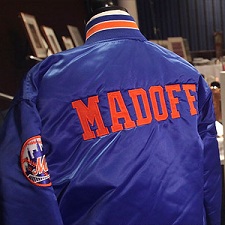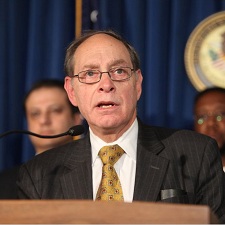KASTEN: ATLANTA TO D.C. TO L.A. FOR $2 BILLION
Wednesday, March 28th, 2012Ownership in Major League Baseball is in such a state right now that Bud Selig looks like the Little Dutch Boy sticking his finger in the holes in a dyke to keep sea water from flooding the city it was built to protect.
The flood facing the baseball commissioner is the sale of teams, and it receded somewhat Tuesday night with the $2 billion sale of the bedraggled Los Angeles Dodgers. But the tide is still rising in southern California with the uncertain status of the San Diego Padres, who could suddenly be in play. It must be something in the sand of the beaches in southern California.
The finale to Frank McCourt’s destructive ownership of the Dodgers was unexpectedly resolved Tuesday night when McCourt accepted the historically high bid by a group that includes Stan Kasten, a long-time baseball executive, and Magic Johnson, and that is funded primarily by Mark Walter, chief executive officer of the financial services firm Guggenheim Partners.
The timing was unexpected because the auction among three groups had been scheduled to take place Wednesday. But less than six hours after the owners, on a 5 p.m. conference call, unanimously approved all three finalists, the Dodgers, without explanation of the early result, announced the sale at 11 p.m Eastern time Tuesday night.
It’s possible that the Guggenheim group offered $2 billion after it was approved, and McCourt’s advisors from Blackstone took it to the other finalists, who said they were not prepared to go that high. That scenario would have eliminated the need for a Wednesday auction.
The magical Magic, long a hero in Los Angeles, was the featured name in the announcement and news reports of the outcome. In my view, however, Kasten was the magical presence in the winning group. Three months ago and again more recently, this column said the Guggenheim group was the leading contender, and the reason was Kasten, a long-time friend and ally of Selig.
True, the bidders had to deal with United States bankruptcy court, and the Kasten group had to at least match other bids. But McCourt had the final say on accepting the winning bidder, and I have no doubt that the commissioner exerted some influence on that acceptance.
Yet in most reports of the sale, Kasten was an oh-by-the-way mention, very secondary to Johnson.
The first words of the Los Angeles Times report were “a group led by Magic Johnson.” The New York Times began its report with “a group headed by Magic Johnson.” In its lead paragraph the New York Daily News used “a group led by basketball Hall of Famer Magic Johnson.”
 MLB.com’s headline said “Dodgers sold to Magic Johnson’s group” and the start of the story said, “A deal has been consummated between the Dodgers and Magic Johnson’s bidding group.” ESPN.com referred in its lead paragraph to “the Magic Johnson group.”
MLB.com’s headline said “Dodgers sold to Magic Johnson’s group” and the start of the story said, “A deal has been consummated between the Dodgers and Magic Johnson’s bidding group.” ESPN.com referred in its lead paragraph to “the Magic Johnson group.”
Give the Associated Press credit. Its reports by Ron Blum, had Johnson and Kasten in the leads of its reports. That’s one of the good things about the AP, where I began my career. Its reporters learn to get multiple facts into their leads without cluttering them.
Why was I so certain about Kasten? As the long-time president of the Atlanta franchise, he turned it into the strongest organization in Major League Baseball. As an adviser, he guided the Lerner family through its successful effort to buy the Washington Nationals in 2006 and as their president laid a strong foundation for the construction of a growing organization.
Besides having great respect for and confidence in Kasten as a top club executive, Selig found in him a strong, intelligent and close ally in the labor wars that the owners fought with the players for decades.
Well, on second thought, how smart could Kasten have been to join in Selig’s many years of failed labor strategy? I’ll leave that for another time.
Not to be overlooked is Johnson’s presence in the group. As a result of his contributions to the Lakers’ success and his community efforts, Johnson is a god to Los Angeles sports fans and by his name and presence alone will bring many of them back to Dodger Stadium.
Because the Dodgers are in bankruptcy, the court has to approve the sale. It should have no trouble doing that, and the Dodgers’ creditors should be delighted with the sale price. Jamie McCourt, on the other hand, may have second thoughts about letting her ex-husband off too easily by agreeing to a payment of $131 million.
The sale of the Dodgers lifts a large load off Selig’s shoulders. Now he has only one bizarre franchise matter to deal with.
The Padres’ owner, John Moores, thought he had sold the team to Jeff Moorad three years ago, but now he has to play a do-over. Will he try to sell the team a second time or hold onto? He was not prepared to disclose his plans Tuesday.
“I have no comment,” he said on his cell phone. “The only thing I’ll comment on is my date of birth.”
Having no need for that bit of information, I began to ask the question I was seeking an answer to – did he plan to sell the Padres? – but he abruptly ended the call.
A high-ranking executive of another club said Moores hadn’t made his plans known to other owners but added, “Everyone believes he will sell the club.”
A club executive said, “Once the Dodgers thing shakes out, we’ll have a better idea.”
Some people had speculated that once the Dodgers’ sale had been completed, there would be a lot of losers available as potential bidders for the Padres, not only the two losers in the auction (Steve Cohen and Stan Kroenke) but also the more than half dozen groups that entered bids for the Dodgers but didn’t make the auction.
However, as one follower of the sale of baseball teams observed, “The difference between buying the Dodgers and the Padres is like the difference between a Mercedes and a Buick.”
He said he doubted that Cohen, the billionaire founder of a hedge fund, would want to buy the Padres, and he had the same view of Kroenke, who owns the St. Louis Rams football team.
I spoke to one losing Dodgers bidder, Dennis Gilbert, the former player agent, who has been unsuccessful more than once in trying to buy a team.
“I don’t want to comment,” he said. “The team isn’t for sale.”
One interested buyer, who spoke on the condition of anonymity, speculated that it was possible that Moores would no longer want to sell the team. “From what I’m reading” he said, “he’s waiting for his t.v. deal to be done. Depending on the t.v. deal, he might not want to sell.”
Moores, who like McCourt is divorced from the woman who was his wife when he bought the team, thought he had sold the Padres three years ago or at least reached an agreement to sell the team.
Moorad and his group of investors had agreed to buy 100 percent of the Padres over five years, had purchased 49 percent and were looking to accelerate the rest of the process. They had planned to take 100 percent control in January, a step Moores eagerly favored, but the owners delayed a scheduled vote at their meeting that month.
 According to baseball officials, the delay was the result of concerns that the Moorad group didn’t have the money to operate the franchise successfully, and the owners and the commissioner didn’t want a repeat of the McCourt fiasco.
According to baseball officials, the delay was the result of concerns that the Moorad group didn’t have the money to operate the franchise successfully, and the owners and the commissioner didn’t want a repeat of the McCourt fiasco.
Moores, however, was so angry at the delay that he initially opposed a two-year contract extension for Selig, who had let the owners know that it would take a unanimous vote for him to accept an extension of his term. Subsequently, though, Moores changed his vote and made it unanimous, presumably after the Moorad situation was explained to him.
Moores has also changed his opinion of Moorad. “”I’ve never consistently been so wrong about anything that’s happened to me,” Moores told the San Diego Union-Tribune about his original support of Moorad.
Moorad stepped down as the Padres’ chief executive officer last week, saying he was remaining as vice chairman and making the move to focus on negotiations for a new television contract. I found that explanation difficult to believe. Less than a week later, it became known that Moorad was out altogether.
As for his group’s share of ownership, a club executive said it wasn’t known how it would be worked out.
A baseball official said owners suspected that Moorad was trying to get the t.v. deal done, then use that money to help buy the remaining 51 percent of the Padres. If that was so, Moorad, who did not return a call seeking comment, should have known that trick wouldn’t work.
McCourt tried it when he was still trying to salvage the Dodgers, planning to use television revenue to bolster his phantom finances, but Selig rejected the idea and forced McCourt to sell.

 How did the Rangers shed $48.7 million from their payroll for the 2004 season? They got rid of the most sizable chunk, $22 million, by trading Alex Rodriguez to the Yankees. Another $22 million disappeared with the expiration of the contracts of Juan Gonzalez and Rafael Palmeiro.
How did the Rangers shed $48.7 million from their payroll for the 2004 season? They got rid of the most sizable chunk, $22 million, by trading Alex Rodriguez to the Yankees. Another $22 million disappeared with the expiration of the contracts of Juan Gonzalez and Rafael Palmeiro.
 That’s why they reportedly are hundreds of millions in debt. That’s why they are spending no money for players. That’s why they are headed for last place in their division, seen as finishing behind even the Washington Nationals.
That’s why they reportedly are hundreds of millions in debt. That’s why they are spending no money for players. That’s why they are headed for last place in their division, seen as finishing behind even the Washington Nationals.

 In reporting on the settlement, the Times tried to recover, reversing its previous position by mentioning setbacks Picard had suffered. In addition, the news report, nearly 90 percent through the articles, said, “Mr. Picard might also have had second thoughts about the strength of his case.”
In reporting on the settlement, the Times tried to recover, reversing its previous position by mentioning setbacks Picard had suffered. In addition, the news report, nearly 90 percent through the articles, said, “Mr. Picard might also have had second thoughts about the strength of his case.”